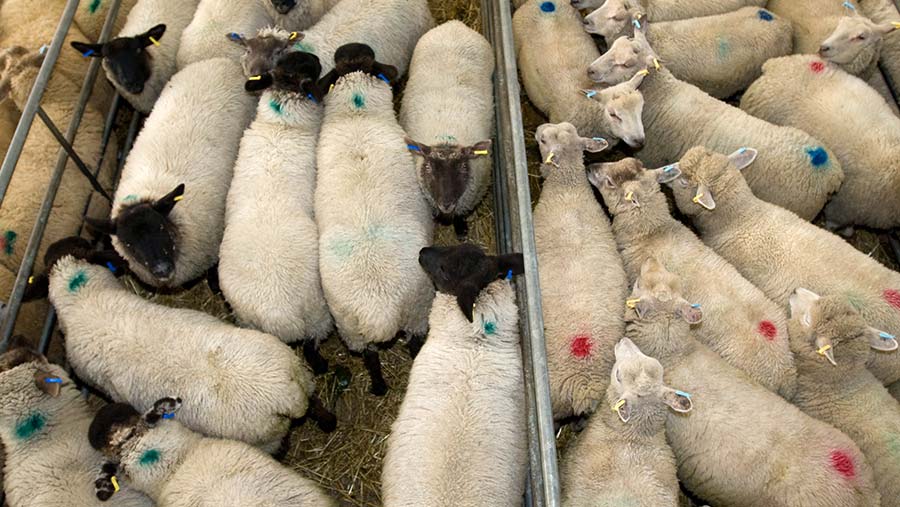Hope for lamb price rise after deadweight hits new 2022 low
 © Tim Scrivener
© Tim Scrivener The lamb trade is looking for a seasonal lift after hitting a new 2022 deadweight low.
Tightening supply should offer some support to markets, while demand at retail level is still lacklustre.
Deadweight lamb prices in the week ending 5 November were 43.9p/kg below the same week last year.
See also: NI lamb price is falling short of costs of production
The deadweight SQQ dropped by 6.9p/kg to average 512.6p/kg for the week ending 5 November, after having fallen every week but two since mid-June.
However, Jonny Williams, joint operations director of livestock marketing group Farmstock, said there had been a big jump in prices this week at some abattoirs.
“I think it will be about 520-525p/kg by the close of the week in a lot of places,” he said.
Throughputs have been consistently higher than year-earlier levels during the past couple of months.
However, throughputs to 5 November in the AHDB’s sample of GB abattoirs dropped 11% on the previous week.
The gap between retail and farmgate lamb prices has been widening in recent months.
When deadweight lamb prices peaked in mid-June, the gap to lamb mince at retail was 216p/kg, but this has since more than doubled to 500p/kg.
Liveweight prices
The GB liveweight SQQ averaged 243.93p/kg for the week ending Tuesday 8 November, up 18.8p/kg on the previous week.
Throughputs at GB auctions were up 11% on the previous week to 101,600 head.
Gordon McWhirter, livestock marketing specialist at producer group Meadow Quality, said price increases were being driven by tightening supply rather than increased demand.
“It’s becoming difficult to know where lambs are going to come from in the next month or so; they seem to have dried up a bit.”
Trade at Exeter Livestock Centre was up by 14p/kg on Monday 8 November, and throughputs were up marginally, with 554 prime lambs being sold and an SQQ of 241p/kg.
Exeter-based auctioneer Russell Steer of Kivells said trade had been a bit better, but it was still not where it needs to be.
“Our SQQ was at about 240p/kg. Heavy lambs were a bit brighter, but there is a long way to go,” he said. “Lighter lambs are still a decent trade as well, which must be export and supermarket driven.”
Store lambs
GB store lambs were up by £1 a head on the previous week to average £70 a head for the week ending 5 November.
Store lambs averaged £83.55 a head at Exeter on Friday 4 November.
“All classes, even the real bottom end, were good to sell and some lambs could be £8-£10 dearer again on the week, with the overall average for every lamb sold up £5 on the week,” said Mr Steer.
“I don’t think store lambs will be this dear in six weeks’ time, even if the lamb price does go up,” he said.
There are a lot of drought-affected lambs that have had a tough summer and are going to take a lot of turning around, according to Mr Steer.
Export trade
Nick Allen, chief executive of the British Meat Processors Association, said lamb trade is difficult and as the pound strengthens, it is making lamb exports less competitive.
“It’s quite hard work exporting, certainly on the lamb front. It’s quite hard shifting it anywhere at the moment, with home consumption dropping,” he said.
Sterling stood at £1:€1.14 on Wednesday 9 November. Farmgate lamb prices on the Continent have been rising in recent months, which should offer some support to UK exports.
Light lambs in the EU-27 averaged €746.84/100kg for the week ending 24 October, according to the European Commission, up 11% since early July.
Retail demand
Total spend on lamb declined by 12.5% and volumes fell 19.9% on the year for the 12 weeks ending 2 October, according to Kantar data.
Cautious consumers and food price inflation are limiting demand, with grocery inflation reaching 13.4% in the 12 weeks to 30 October 2022.
Fraser McKevitt, head of retail and consumer insight at Kantar, said: “Consumers face a £682 jump in their annual grocery bill if they continue to buy the same items, and just over one-quarter of all households [27%] now say they’re struggling financially.
“Food and drink spending is generally non-discretionary, so it’s not easy for shoppers to cut back the amount they buy. Many are looking to reduce costs in other ways and the big shift to own-label is still accelerating,” said Mr McKevitt.
Red meat could see Christmas uplift
AHDB senior retail insight manager Kim Heath said turkey shortages, the cost-of-living crisis and new buying trends over the past few Christmas seasons all have the potential to lift sales of red meat this year.
Ms Heath said: “We are likely to see a shift to cheaper roasting joints, benefiting pork. But with a potential shortage of turkeys, there is an opportunity to trade up to beef and lamb for consumers who want a show-stopping centrepiece, especially if they can have more people round the dinner table this year.”
